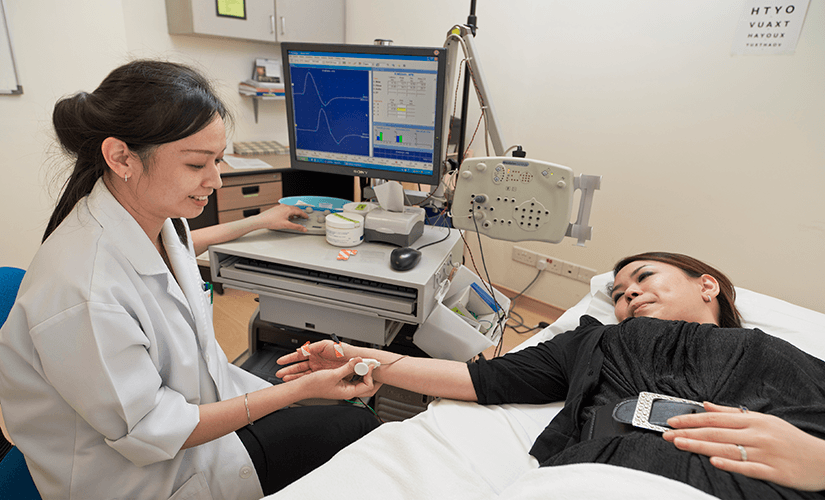
An electromyography (EMG) is a diagnostic test that is used to record the electrical activity of muscles at rest and when they active. Motor neurons transmit electrical impulses to the muscles, instructing them to contract or relax. Active muscles produce an electrical current that is proportional to the level of the muscle activity. An EMG translates these signals into graphs, sounds or numerical values that can be interpreted to understand the health of the muscles.
An EMG can be used to detect abnormalities in the muscles’ electrical activity that can occur in many diseases and conditions, including, but not limited to:
- Muscular dystrophy
- Inflammation of muscles
- Pinched nerves
- Peripheral nerve damage (damage to nerves in arms and legs)
- Amyotrophic lateral sclerosis (neurological disease that attacks nerve cells that control voluntary muscles)
- Myathenia gravis (autoimmune disease that causes weakening of skeletal muscles)
- Disc herniation (abnormal rupture of spine disc)
An EMG is done when patients experience unexplained muscle weaknesses. The test helps to distinguish between problems originating from the muscles themselves, or from nerve disorders. Symptoms that may require an EMG are:
- Tingling
- Numbness
- Muscle weakness
- Muscle pain or cramping
- Certain types of limb pain
Services & Procedures Offered
In order to conduct an EMG, a needle electrode that is attached to a recording machine is inserted into a muscle. The electrode then records the electrical activity in the muscles when it is at rest. Patient will be asked to flex the muscle slowly and steadily, and the electrode will record the change in electrical activity. The electrode may be moved several times in order to collect a variety of different readings in different muscles.Prior to conducting the test, patients are advised to consult the doctor if:
- Are on any medication, as certain medicines can affect the EMG results. Patient may be advised to stop taking certain medications for up to six days before the test
- Have experienced any bleeding problems, or are taking any blood thinners
- Have a pacemaker
Patient is also advised to avoid smoking, and eating or drinking anything that contains caffeine for a minimum of three hours before the test. Patient should wear loose fitting clothes, or will be provided a hospital gown to wear. Patient should also take a bath or a shower before the exam to remove oil on the body. Do not apply lotions or creams to the skin before the exam.




